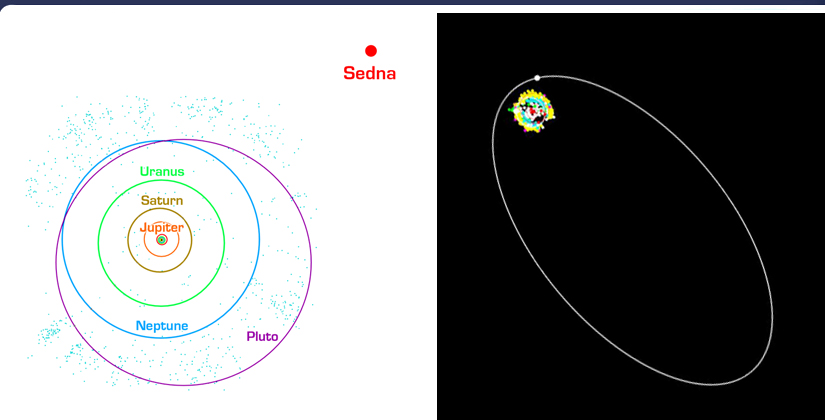Eliptical Orbit of Sedna Hints at Brown Dwarf Twin
Sedna and Sol b?
SolStation.com News
March 15, 2004
On March 15, 2004, a team of astronomers (including Mike Brown, Chad Trujillo, and David Rabinowitz) announced the NASA-sponsored discovery of a very large planetary body (originally designated 2003 VB12) in one of the most distant planetary orbits yet discovered within the Solar System. Confirmed by the Spitzer (infrared) Space Telescope and tentatively named Sedna after the Inuit Goddess of the Sea (from which all creatures of the very cold Arctic sea were created), it is currently located around 90 AUs from our Sun, Sol -- an orbital distance that is roughly three times farther out than that of Pluto or Neptune -- but will eventually move as much as 10 times farther away (around 990 AUs) in a 12,260-year orbit around Sol; it's orbital semi-major axis is around 532 AUs with an extremely high eccentricity of 0.857. Based on its current distance, brightness, and presumed albedo or ability to reflect light, Sedna has been estimated to have more than half the diameter of Pluto and may be larger than any other planetary body found since Pluto -- at 730 to 1,470 miles or 1,180 to 2,360 kilometers (km) across, compared to Pluto's diameter of around 1,440 miles or 2,320 km ...
Sedna is the second most reddish planetary body in the Solar System, after Mars. Although originally believed to have a slow rotation of 40 days which suggested that Sedna might have its own moon, astronomers eventually determined in 2005 that its rotation speed is actually around 10 hours (more). The icy object will move closer to the Sun over the next 72 years -- to 76 AUs of Sol -- before receding back towards the inner Oort Cloud ...
In 1999, U.K. and U.S. astronomers independently reported finding evidence that one or more large planets or brown dwarfs gravitationally bound to the Sol may be perturbing the orbits of two different groups of long-period comets at the outer reaches of the Oort Cloud into the inner Solar System with the assistance of galactic tidal forces. The U.S. team (led by John J. Matese) estimated that the substellar object has a size of about three Jupiter masses and orbits Sol at 25,000 AUs in a wide band running through Constellation Cassiopeia and the the North Star, Polaris, (August 2000 update), while calculations by John B. Murray of the U.K. focus on a smaller region centered around Constellation Delphinus at an estimated distance of 32,000 AUs. Some astronomers believe that Matese and Murray are being misled by random statistical fluctuations or the past gravitational effects of passing stars. However, confirmation through direct observation by the upcoming, new generation of infrared telescopes such as the Stratospheric Observatory for Infrared Astronomy (SOFIA) and the Space Infrared Telescope Facility (SIRTF) may be feasible if the positions of the hypothesized objects can be adequately constrained.
Analysis
Explaining the extremely long eliptical orbit is a significant problem for astronomy as any solution would have to involve another large body orbiting with Sedna to keep it coming back to Sol every 12,260 years. Sedna's mass in itself cannot sustain its orbital path without major help from what is likely a Brown Dwarf companion star - a twin dark sun as is described throughout ancient lore.
The Binary Companion Theory is being advanced by the Binary Research Institute, whose calculations suggest the likelihood of discovery of a large, nearby dark body has been recognized by several groups who are quite actively scanning for the object.
Native American tradition from Nahuatl language groups have revealed their ancient prophecies transmitted orally. The Hopi Elders speak of Talawva, the Third phase of Creation beginning when a small Red Star makes its presence known as the Sun's twin. The Maya give a similar account in the Pyramid of Fire Codex of a new Solar Age on this planet when both the pyramids and the skies will be 'in flames.'
Modern science has acknowledged that Earth magnetic field has already begun reversal, causing the increasingly high levels of tectonic activity which may culminate in a solar-system-wide magnetic reversal on December 22, 2012.





